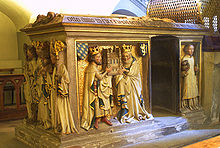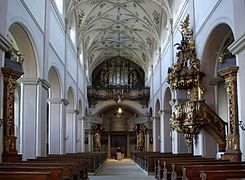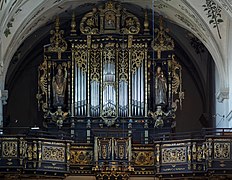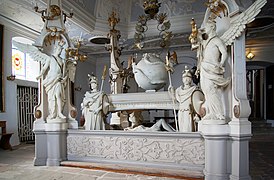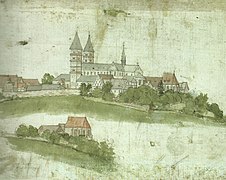Michelsberg Monastery
Michelsberg Monastery (also Michaelsberg ) is a former Benedictine abbey in Bamberg in Bavaria in the Archdiocese of Bamberg . After its dissolution in 1803, the premises were used for the United Katharinen- and Elisabethen-Spital , which was moved there . This retirement home is still there today.
history
After the establishment of the diocese of Bamberg by Emperor Heinrich II , the first bishop of Bamberg, Eberhard , founded the Benedictine monastery of St. Michael as an episcopal own monastery in 1015 . Accordingly, the respective abbot was exclusively subordinate to the Bishop of Bamberg. The monks for the Michelsberg initially came from the Abbeys of Amorbach and Fulda .
The monastery experienced its first heyday under the Bamberg Bishop Otto in the 12th century, especially with the canonization of the patron (of the monastery), Bishop Otto, who was buried in the monastery church in 1189 and the papal protection of the abbey. From 1251, Michelsberg Abbey gained increasing independence from the Bamberg bishopric. The bestowal of pontificals to the abbots took place before 1185. The most important economic basis of the monastery was based on its large estates in 441 places of the diocese.
In 1435 the monastery was plundered in conflict with the citizens of Bamberg. The Michelsberg Monastery was also affected in the Peasants 'War of 1525, in the Second Margrave War and during the several years of occupation by the Swedes in the Thirty Years' War . The Benedictine abbey experienced a new heyday in the 17th and 18th centuries. Century.
During the secularization in 1802, the monastery still had stately property in the city of Bamberg and in no fewer than 141 places in the surrounding area. On November 30, 1802, Bavarian troops confiscated the property of the monastery. The monastery library was transferred to the Bamberg Electoral Library, founded in 1803 (today's Bamberg State Library ). The 24 remaining monks had to leave the monastery. The monastery came into the possession of the city of Bamberg , which moved the old hospitals from the city center to the Michelsberg in November 1803 at the request of the citizens. The citizen hospital still exists today.
Monastery church
The first church was built around 1015 and probably fell victim to an earthquake in 1117. The current building is essentially a Romanesque church that was consecrated in 1121. In 1610 it was damaged in a fire, as a result of which the nave (with the ceiling composition of the sky garden completed in 1617) and the west building (with the two west towers) had to be rebuilt as good as new. The organ prospect , which has been preserved to this day, was erected soon after the fire in 1610 and is an important work of the German late Renaissance . From 1696 Leonhard Dientzenhofer designed a two-storey baroque facade under Abbot Christoph Ernst. Johann Dientzenhofer designed the terrace in front of it in 1723. The former abbey church of St. Michael is now a branch church of the cathedral parish.
In 1833 the grave monuments of the Bamberg bishops from the 16th to 18th centuries, which were removed from the cathedral on the instructions of King Ludwig I, were erected here. In their Bamberg travel guide from 1912, Schneider and Ament write about the Michelsberg Monastery: “A completely foreign part of the church furnishings are those prince-bishop's grave monuments, which King Ludwig I ordered to be removed from the cathedral during the restoration and in the Michelskirche were moved: "
In the late autumn of 2012, considerable structural damage was found, so that extensive renovation work is necessary and the church has no longer been accessible since then. These renovation measures on both the church and the monastery complex are expected to last until 2025.
Central nave with herbarium
The eye-catcher when entering the church, in addition to the choir altar without architecture, is the pulpit and the vaulted ceiling with herbs, flowers and animals, which is also continued in the aisles.
The ceiling painting shows (as it were as a painted garden for paradise) almost 600 different plants. The ceiling of the central nave, the aisles, the transept, the crossing and the west gallery is painted with a total of 580 plants, including exotic plants such as pineapple , cotton , pomegranate or tobacco and also native trees, bushes and grasses such as apple, pear, blackberry and Beech. The locals refer to the ceiling composition, completed by four painters in 1617, as the herb garden or sky garden, which refers to the monastery herb gardens.
The ceiling painting depicting plants of different origins was created around 1610 to 1614 and probably had (like the Allendorf Chapel in Würzburg ) an edition of a Herbarius by Matthias de L'Obel kept in Bamberg as a template.
It is interesting that plants that only became known in Germany in the 16th century are depicted on the vault. These include, for example, lilac , jasmine and laburnum . They came to Bamberg through the natural scientist Carolus Clusius , who worked in Vienna . But the painters of the herbarium also borrowed from pamphlets.
The paintings in the vaulted areas of the side aisles were only applied in the 18th century, a good hundred years later. Several songbirds and six parrots are the only animals on the ceiling paintings.
Almost all plants are shown in a flowering or fruit-bearing state. Errors in the representation, including the color rendering, are rare: only the blossom of the bean is painted yellow instead of white. There are focal points in the arrangement. These are obviously due to the classification of the plants according to hierarchies. The paintings seem to be based on Albertus Magnus , who described the trees as the most perfect plants. The plants, mushrooms and crops that he least valued, are not shown. Trees and bushes predominate in the crossing and the transept, and fruit trees in the central nave. In the side aisles, there are mainly flowers with strong blossoms such as daffodils and gentians .
The art historian Cornelia Skodock sees connections between the ceiling paintings and the time in which they were created. The paintings were supposed to represent the entire known flora, but they were also to be seen as a worship of creation and could be understood as a counter-Reformation measure.
Left (north) aisle
In the left aisle there are seven grave monuments of prince-bishops of the Bamberg Monastery , which were moved there from the cathedral :
- Weigand von Redwitz († 1556)
- Johann Philipp von Gebsattel († 1609)
- Johann Georg I. Zobel of Giebelstadt († 1580)
- Ernst von Mengersdorf († 1591)
- Melchior Otto Voit of Salzburg († 1653)
- Neidhardt von Thüngen († 1598)
- Veit II of Würtzburg († 1577)
In the left aisle there are also:
- Side altars
- Niche side altar
- Figures to the side of the vestry entrance
- Choir
- Choir altar
- Choir stalls
- organ
- Otto Altar
Crypt with grave of the holy bishop Otto I.
The crypt was created by installing the choir in the baroque period. It is also used as a museum on the life of Bishop Otto I of Bamberg (1060–1139). His high grave on the west side of the crypt was built in the first half of the 15th century and is connected to the Otto altar in front of it. It has the peculiarity that it has a hatch that enabled the pilgrims to come very close to the relics of the bishop , who was canonized in 1189, and to show their veneration through the bent posture. To this day, believers make pilgrimages to this high grave, which is supposed to free them from back problems when they slip through.
Reliefs on the north side:
- to the left of the pass-through the saints Heinrich II. and Kunigunde with the model of Bamberg Cathedral , in the relief at the top left the coat of arms of the Duchy of Bavaria and opposite the coat of arms of the bishopric of Bamberg
- to the right of Stephen's slip- through (in the dalmatic of the deacon with martyr's palm and stones of his martyrdom )
Reliefs on the east side:
Archangel Michael , Mary with child and a holy bishop (Bishop Otto I of Bamberg or the Franconian Apostle Kilian )
Reliefs on the south side:
- to the left of the passage Laurentius (in the robe of the deacon and with the rust as his attribute)
- to the right of the hatch John the Evangelist (with book and eagle) and John the Baptist (with the Lamb of God).
The cover plate contains the full-body figure of Bishop Otto, on the lower left side of which an abbot, previously unspecified, kneels, and lettering on three sides. In addition, the only colored representation of a draco bambergensis , a Bamberg dragon, is attached to the grave .
On the east wall of the crypt is the old grave slab of the lost first high grave (around 1280) of Bishop Otto I (with pallium , crosier , miter and book).
Right (south) aisle
The right aisle on the outer wall also contains three grave monuments of prince-bishops from Bamberg Cathedral for
- Johann Philipp Anton Freiherr von und zu Franckenstein († 1753)
- Adam Friedrich von Seinsheim († 1779)
- Franz Konrad von Stadion and Thannhausen († 1757)
There is also a memorial for those who fell in World War I as well
- a niche side altar
- the high altar
- Side altars
- the pulpit
- the choir stalls
- Pictures from the life of Bishop Otto
- Figures at the exit of the church
Adjacent chapels
- Lady Chapel
- Holy Sepulcher Chapel
- Interior views
Monastery buildings and gardens
The three-story abbey and convent buildings, built between 1696 and 1712 according to plans by Johann Leonhard Dientzenhofer , are located north of the Michelskirche. In the main or north wing, the large summer refectory (the dining room), the former library, the so-called billiard room and the abbot's chapel are worth mentioning. The chapter house adjoins the cloister in the east wing . These buildings are now used as a retirement home.
To the west of the Michelskirche is the former farm yard of the monastery with the St. Oswald gate chapel . The three wings were built around 1740; Balthasar Neumann also intervened in the planning in 1742 . A brewery museum has been set up in the former monastery brewery in the north wing.
The Mercury Fountain designed by Johann Nikolaus Resch is in the courtyard .
The terraced gardens sloping to the north and north-east of the Regnitz complex were laid out under Abbot Ludwig Dietz († 1759) and his successor Gallus Brockard († 1799). There is also an orangery in the southern area of the monastery garden .
In 1849, Johannes Wildberger opened an orthopedic sanatorium in the monastery buildings.
The south-sloping slope, which has been known as a vineyard under the name Camerathen since the 12th century, was recultivated as a vineyard for the 2012 State Horticultural Show . The Silvaner that grows here as well as the fine brandies and liqueurs made from the fruits of the monastery garden are marketed under the “Bamberger Stiftsgarten” brand.
Varia
The crime comedy Pfarrer Braun - Braun under suspicion with Ottfried Fischer in the lead role, first broadcast by ARD on April 12, 2007, takes place largely on the Michelsberg, which is also repeatedly shown in aerial photos.
- Exterior views
Michaelsberg Monastery seen from the rose garden
literature
- Peter Schneider and Wilhelm Ament: Bamberg. Speyer, 1912.
- Peter Ruderich: Former Benedictine Abbey Church of St. Michael in Bamberg . DKV art guide No. 614/3 Deutscher Kunstverlag Munich Berlin.
- Anja Hofmann: Sacred emblems in St. Michael zu Bamberg. Harrassowitz publishing house 2002, ISBN 3-447-04413-6 .
- Werner Dressendörfer: The sky garden of St. Michael in Bamberg. With a short guide through the church. Kunstschätze-Verlag 2009, ISBN 978-3-934223-28-8 .
- Werner Dressendörfer: Spoken through the flowers. Plants in the "Himmelsgarten" of St. Michael in Bamberg. Symbolism, botany, medicine. Kunstschätze-Verlag 2012, ISBN 978-3-934223-38-7 .
- Heinrich Joachim Jaeck : Basics of the history of the former Michelsberg monastery near Bamberg. Developed from his handwritten sources . Munich 1826 ( digitized ).
- Wolfgang Wüst: Michelsberg Monastery in Bamberg - Everyday Life, Consumption and Economy as Reflected in the Account Books 1580–1802 / 03. In: Norbert Jung / Holger Kempkens (eds.), 1000 years of St. Michael in Bamberg, Bamberg 1015–2015. In the protection of the angel (Publications of the Diözesanmuseum Bamberg 27) Petersberg 2015, ISBN 978-3-7319-0235-5 , pp. 180-187.
Web links
- Michelsberg Monastery (House of Bavarian History)
- Digital copies of manuscripts from the Bamberg State Library from the library and scriptorium of Michaelsberg Monastery
- Digitized version of the Benedictine Rule with lectionary and necrology from the Michelsberg Monastery (Msc.Lit.144) of the Bamberg State Library
- 1614 renovation work on Michelsberg
- St. Michael Monastery near Foracheim
Individual evidence
- ↑ Brigitte Hoppe: Herb books, garden culture and sacred decorative plant painting at the beginning of the 17th century. In: Rechenpfennige. Essays on the history of science. Edited by the research institute of the Deutsches Museum. Munich 1968, pp. 183-216, here: p. 196 f.
- ↑ Brigitte Hoppe: Herb books, garden culture and sacred decorative plant painting at the beginning of the 17th century. In: Rechenpfennige. Essays on the history of science. Edited by the research institute of the Deutsches Museum. Munich 1968, pp. 183-216.
- ↑ Christina Becela-Deller: Ruta graveolens L. A medicinal plant in terms of art and cultural history. (Mathematical and natural scientific dissertation Würzburg 1994) Königshausen & Neumann, Würzburg 1998 (= Würzburg medical-historical research. Volume 65). ISBN 3-8260-1667-X , pp. 215-217.
- ^ Bruno Neundorfer: St. Michael Bamberg . Schnell & Steiner, Regensburg, 9th edition 1994, p. 9f.
- ^ Bruno Neundorfer: St. Michael Bamberg . Schnell & Steiner, Regensburg, 9th edition 1994, pp. 5 and 9f.
Coordinates: 49 ° 53 ′ 37 ″ N , 10 ° 52 ′ 38 ″ E









